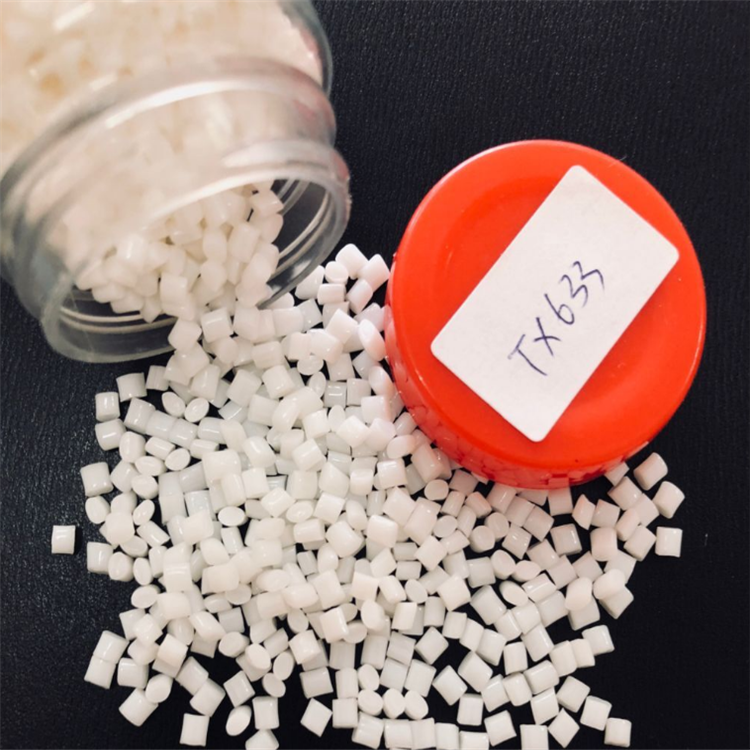Model No.︰TX506
Brand Name︰Sinopec
Country of Origin︰China
Unit Price︰-
Minimum Order︰25 kg





Price Terms︰ FOB Guangdong
Payment Terms︰ TT
Packing︰ space bag
Lead Time︰ 3day
SKU︰ 500T
Standards Certificate︰ SGS REACH ROSH
specifications︰ 25kg/bag
Advantages︰
mechanical property
By adjusting the ratio of soft to hard segments, the hardness of TPEE can be from Shao's 30-82D, and its elasticity and strength are between rubber and plastics. Compared with other thermoplastic elastomers, TPEE modulus is higher at low strain than other thermoplastic elastomers with the same hardness. When modulus is an important design condition, TPEE can reduce the cross-sectional area and material consumption of products. TPEE has very high tensile strength. Compared with polyurethane (TPU), the compressive modulus and tensile modulus of TPEE are much higher than those of TPU. TPEE and TPU with the same hardness can bear a larger load. Over room temperature, TPEE has a high flexural modulus, but it is not as hard as TPU at low temperature, so it is suitable for making cantilever beam or torque type parts, especially high temperature parts. TPEE is low and gentle, good low temperature notched impact strength is better than other TPE, and wear resistance is similar to TPU. Under low strain conditions, TPEE has excellent fatigue resistance and less shield loss, which combines with high elasticity, making it an ideal material for multiple cyclic loads. Gears, cots, flexible coupling and belts can be used.
thermal property
TPEE has excellent heat resistance, the higher the hardness, the better the heat resistance; TPEE is heated continuously for 10 hours at 110-140 C without loss of weight, and heated at 160 C and 180 C for 10 hours respectively, the weight loss is only 0.05% and 0.1%. Therefore, the use temperature of TPEE is very high, the short-term use temperature is higher, and it can adapt to the baking temperature of automobile production line (150-160). And it has little loss in mechanical properties at high and low temperatures. When TPEE is used at 120 C or above, its tensile strength is much higher than that of TPU. Besides, TPEE has excellent low temperature resistance. The brittle point of TPEE is lower than - 70 C and the hardness is lower, the cold resistance is better. Most TPEE can be used at - 40 C for a long time. Because TPEE exhibits balanced performance at high and low temperatures, its working temperature range is very wide, and it can be used at - 70 ~ 200 C.
Chemical resistance
TPEE has excellent oil resistance. It can withstand most polar liquid chemical media (such as acids, alkalis, aminodiols) at room temperature, but has no effect on halogenated hydrocarbons (except freon) and phenols. Its chemical resistance increases with the increase of its hardness. TPEE has good anti-swelling and anti-permeability for most organic solvents, fuels and gases. Its oil permeability is only 1/3-1/300 of oil-resistant rubber such as chloroprene, chlorosulfonated polyethylene and Nitrile-Butadiene rubber, but its hot water resistance is poor. Adding polycarboimide stabilizer can obviously improve its anti-hydrolysis performance.
Aging resistance
TPEE has excellent chemical stability under many different conditions, such as water mist, ozone and outdoor atmospheric aging. Like most elastomers, degradation occurs under ultraviolet light, so for outdoor applications or products exposed to sunlight, ultraviolet protection additives, including carbon black and various pigments or other shielding materials, should be added to the formulation; besides, TPEE has different degree of hydrolysis.
Product application
TPEE is mainly used in areas requiring shock absorption, shock resistance, flexibility, sealing and elasticity, oil resistance, chemical resistance and sufficient strength. Such as: polymer modification, automotive parts, high and low temperature wire sheath, hydraulic hose, shoe material, transmission belt, rotary tire, flexible coupling, muffling gear, elevator slideway, anti-corrosion, wear-resistance and high and low temperature materials in chemical equipment pipeline valves, etc. TPEE products with high performance are TPEE 5526, 5556, 4056, 4069 of DuPont Company, USA. They are widely used in wires, cables and seals.




